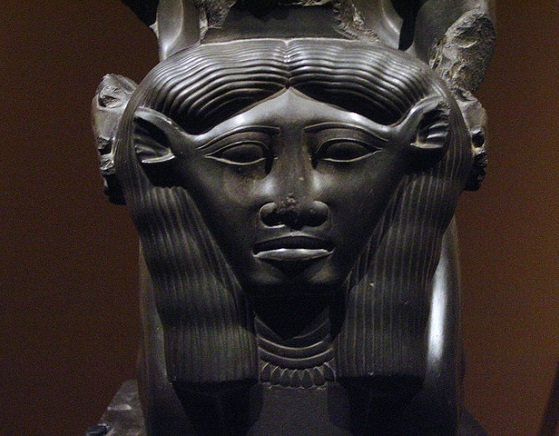Hathor, Isis, the Holy Mother and Mary Magdalene: Who Tells Your Story for You?

There is a significant yet suspicious duality in the representation of two competing female archetypes of goddesses: Mary the Mother and Mary Magdalene.
This kind of duality is not only artificial, but also undoubtedly a figment of the ascetic mind of old patriarchs afraid of anything fun and sexy, unable to conceive a Feminine that is empowered both intellectually and sexually, yet one that can simultaneously be a mother-figure.
The reason why this could only be the result of the limited and poor imagination of paranoid patriarchs is that nearly every woman — if she explores her powers and possibilities — knows that she can, if she chooses so, be all or any of the above. What the patriarchs could not imagine, many women have managed to live.
But this was only intuition on my part until I did my research. At the beginning, I simply and innocently wanted to explore the Isis archetype, as there have been so many strange things written about her that I wanted to set the record straight.
Also, with my academic background, I am often suspicious of the New Age take on the ancient goddesses, where imagination and research are too freely mixed, or so I believed. Fortunately, I came across a wonderful book, Goddesses in Myth, History and Culture, and found within a chapter on Isis with sufficient references and research to satisfy me.
Isis not only has a relationship to Inanna, Ishtar and Mary Magdalene, but on her own, she also has a fascinating Egyptian history. Although I have no doubt she is an alternate version of Inanna, she also has other connections, and one of them is to Hathor.
I love Hathor, as she is a sexy mama who liked her fun and did not apologize for it. A true bon vivant, she is often represented in exactly the same way as Isis — as a beautiful young woman, with some of their portrayals indistinguishable from one another. There is a good reason for this.
Hathor, as Krista Rodin asserts in the book’s chapter From Heaven to Hell, Virgin Mother to Witch: The Evolution of the great goddess of Egypt, merged at some point with Isis. She is also often mentioned as the consort of Horus, who was Isis’ son.
Pay very clear attention here to how mainstream media and research represent goddesses in general: goddesses are always first defined as someone else’s consort or as mothers, even if they came before and were more powerful than the gods who came after them!
But this important observation aside, both Hathor and Isis are often depicted with horns on their heads — something they inherited from an even earlier goddess, Nut, who was the original Egyptian Mother of the Sky.
The sky, in later mythologies, was almost exclusively considered to be male, as it was considered more spiritual than the Earth, while the Feminine was deemed to be bound to matter and therefore lower.
Other representations of Hathor-Isis include a cow, a winged goddess, lioness (when angry), a cat, and even a hippopotamus. The cow had only good connotations, as Hathor’s milk was understood to be the milk of life from a wonderful earthly power of life and enjoyment. She was a goddess who loved to dance and the enjoyed sensuality of life in all its forms.
In this aspect, Hathor is very similar to the Mesopotamian Goddess Ishtar.
But the similarities between Hathor and Isis end here. In many ways, Isis takes on other and more serious qualities, such as spiritual wisdom, as well as being goddess of the underworld and magic, the Virgin Mother of Horus, and the sister-wife of Osiris, whom she resurrected.
The last two qualities were later copied and adjusted in Christianity to suit the image of the Holy Family, as well as being aligned with the story of the resurrection in the presence of Mary Magdalene.
The more mysterious and magical qualities of Isis, according to Krista Rodin, included influence over the sun and moon, influence over time, the ability to give the breath of life to us, the ability to give us our earthly personality (our ba) and the ability to heal, which is why many of the priests in her temples were also physicians.
Interestingly, Isis, like the Sumerian and Assyrian Goddess Inanna before her, was also involved in divine mischief. As the story goes, Isis outwitted the ancient God Ra and forced him to tell her his secret name in which his power was contained. This was very same way that Inanna tricked her grandfather to steal his Me (power).
However, while Inanna simply got her grandfather drunk, Isis nearly strangled Ra to death by creating a serpent out of her saliva and earth. The same story is later repeated in different versions in the Bible — for example, in Jacob’s theft of his brother’s blessing and in Eve’s mischievous cooperation with the Serpent in the Garden of Eden.
The difference here is that all the power — good and bad — was taken away from the female protagonists and given to men.
The influence of Isis was so great that even in early Christian times, she could not be easily dismissed by the Fathers of the Church. Isis had temples in her name all over the Roman Empire, and many powerful families paid her homage. The last temple in her name was only destroyed as late as the sixth century, which is a great indication of the endurance of her power.
One of the more interesting questions to ask is: what happened afterwards?
Krista Rodin shows how, in the fifth century, when worship of Isis was still powerful, the Church simply decided to adopt her as the Holy Mother, which she had been all that time as the mother of Horus (and often represented as such). That is, they used the nice and motherly part of Isis.
Thus, Isis became incorporated into the dogma, but only after she had been reinterpreted again and stripped of her more dangerous sexual and mysterious/magical qualities.
As for the magical and darker part of Isis, it was reconfigured to that of a damned witch. The witch was incorporated into the pagan traditions of Europe — the last surviving traditions to allow female priestesses.
Ellen Reed, in her book Circle of Isis: Ancient Egyptian Magic for Modern Times, writes that the worship of Isis became a part of the revival of Wicca (modern witchery) tradition after the Second World War. This tradition includes rituals through which ‘the Priest calls a Goddess to a Priestess who serves as a vessel… the Goddess speaks through a Priestess’ to the rest of the group or to an individual.
So, Isis’ divine genealogy is complex, and I still stand by my original point here — until I find a better explanation — that Isis’ story, like many repressed representations of the Divine Feminine, is the same recurring story of the Goddess which occurs under many different names and with only slight changes in the plot and character development.
I have no doubt hers is a story that wants to be remembered, re-buried and retold.
The re-telling part is up to us, as it is we who are in control of choosing our own archetypes and our own stories. The times when sanctified bureaucrats from institutionalized belief systems make these choices for us are over.
***
Dr. Joanna Kujawa is the author of ‘Journaling to Manifest the Lost Goddess in Your Life’ and ‘Jerusalem Diary: Searching for the Tomb and House of Jesus’, and many short stories, essays and academic pieces. She sees herself as a Spiritual Detective who asks difficult questions about spirituality, such as ‘Can spirituality and sexuality be experienced as one?’, ‘Who was the real Mary Magdalene?’, ‘How can we include eco-spirituality in our belief systems?’ and ‘How can we bring back the Divine Feminine to create a more balanced and interconnected world?’ Her goal is to create and participate in the shift in consciousness about spirituality, our connection to nature, and our place in the Universe. She has PhD from Monash University, and MA and BA from the University of Toronto. She is immoderately passionate about her Goddess News blog. You could connect with her via her website, Facebook, Twitter or YouTube.
***
{Join us on Facebook, Twitter, Instagram & Pinterest}
Comments
Comments are closed.



In Praise of Darkness: Reclaiming Our Relationship with the Dark Mother. | Rebelle Society
February 5, 2019 at 7:01 am[…] black as well as blue skin. The Buddhist Goddess Tara, in her Black form, is associated with power. Isis, the Egyptian Goddess of Heaven, Earth and the Underworld, is frequently depicted with dark […]